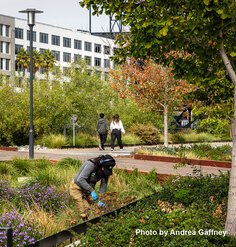10 Years of LAF's Landscape Performance Series

In September 2010, the Landscape Architecture Foundation (LAF) launched its Landscape Performance Series as a new long-term strategic research initiative. This online portal and set of initiatives was developed to build capacity to achieve sustainability and transform the way landscape is considered in the design and development process.
Landscape performance can be defined as a measure of the effectiveness with which landscape solutions fulfill their intended purpose and contribute to sustainability. It involves assessment of progress toward environmental, social, and economic goals based on measurable outcomes. By focusing on research and metrics that are understandable and accessible to a wide array of decision-makers, landscape performance helps to bridge the knowledge gap in the design, development, and policy realms about the importance of landscape solutions. The evidence-based benefits demonstrate return on investment and allow advocates to better make their case. In addition, understanding the performance of built landscapes leads to more effective management, incremental improvements, and better future designs.
Although forms of landscape performance research and evaluation have existed for decades in various disciplines and under different names, LAF has made landscape performance a well-known term, brought it to scale, catalyzed a discipline-wide dialogue, and ultimately cemented the status of landscape performance as a key aspect of landscape architectural research, education, and practice.
The resources on LAF’s LandscapePerformance.org website have increased substantially over the years and now include more than 160 performance case studies, 170 fast facts from published research, LAF’s guidebook to landscape performance metrics and methods, example materials for educators to integrate landscape performance into their courses, and more. The website received the American Society of Landscape Architect’s 2015 Award of Excellence in Communications.
In ten years, landscape performance has had a major impact on the discipline of landscape architecture and beyond.
“LAF's leadership in landscape performance studies have set a foundation for understanding the implications of design on a site.”
“By serving as a convener of academics, practitioners and other industry thought leaders, LAF has developed landscape performance methods and best practices and advanced the profession’s capacity for rigorous research…arming landscape architects with language to articulate the benefits delivered by designed landscapes and the methods to make the case for investment in landscape architecture has augmented the stature of the profession as a whole.”
“The Landscape Performance Series is one of the most significant academic and professional collaborative endeavors in our field in recent decades."
Awareness and use of landscape performance information and evaluation has increased from a near-zero baseline.
- In 10 years, LandscapePerformance.org has received a total of 1.7 million pageviews and attracts 50,000 users annually.
- Over 12,000 people have attended LAF presentations on landscape performance. This includes over 70 conference presentations, presentations for at least 80 firms and organizations, and at least 50 presentations to universities and classes throughout the U.S. and internationally.
- In a 2020 survey, of the 34 practitioners who responded to questions about their integration of landscape performance evaluation and reporting, 88% communicate a project’s value in terms of benefits, 85% estimate benefits of design options, 79% collect baseline data, 79% set quantifiable performance objectives, and 61% conduct post-occupancy evaluation.
- User surveys indicate that while landscape architects are the primary audience, professionals from related disciplines like planning and architecture, as well as developers, site managers, and government employees, also use the LandscapePerformance.org resources.
Landscape performance is leading to better, higher-performing landscape solutions.
- Of the 34 practitioners who responded to a 2020 survey, 62% report designing better-performing spaces thanks to landscape performance data and monitoring.
- 62% use information on LandscapePerformance.org to advocate for a landscape approach to other members of a project team, effectively combatting the perception that the landscape is an “extra” that can be value-engineered out of a project with no impact.
LAF has trained hundreds in landscape performance evaluation.
- In its first 10 years, LAF’s Case Study Investigation (CSI) signature research collaboration and training program has had 84 faculty, 94 students, and 89 design firms participate.
- More than 500 individuals have received intensive training in landscape performance evaluation through CSI and LAF’s half-day landscape performance workshops.
- Evaluating Landscape Performance: A Guidebook for Metrics and Methods Selection has been downloaded over 1,500 times.
Landscape performance has been widely integrated in landscape architecture education.
- In 2016, the Landscape Architectural Accreditation Board (LAAB) included landscape performance as one of the “Assessment and Evaluation” topics to be covered in the Professional Curriculum section of the revised 2016 LAAB Accreditation Standards.
- Of the 72 universities with LAAB-accredited programs, 88% of have directly engaged with LAF on landscape performance through program participation and/or classroom presentations.
Landscape performance has become a focus of landscape architecture research.
- In 2013, the Council of Educators in Landscape Architecture (CELA) added a “Landscape Performance Track” to the content area categories at its annual conference.
- Numerous journal articles and books have been published on landscape performance.
- The LAF case studies and guidebook are frequently cited in journal articles, books, and research papers. Their Digital Object Identifier (DOI) links are clicked more than 5,000 times per year.
In these first 10 years, landscape performance has emerged as a vital way to represent and articulate the value of excellent design and to provide reliable and valid evidence to support design decisions. It also supports and aligns with burgeoning built environment practices, including adaptive management, site commissioning, and performance verification as a pathway for regulatory and rating system compliance.
Landscape performance is clearly helping to strengthen the landscape architecture profession, and we look forward to continuing this work for many more years and tackling new frontiers. Thank you to everyone who has been on this journey with us over the years!










